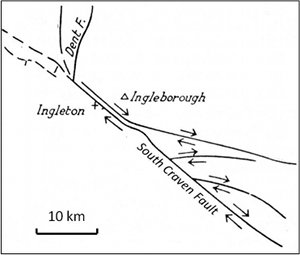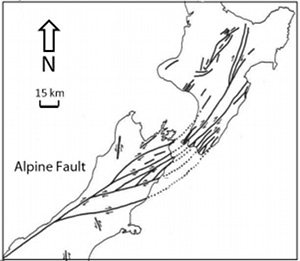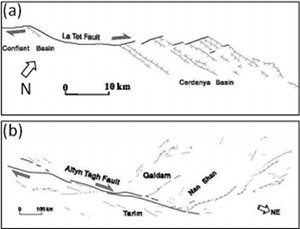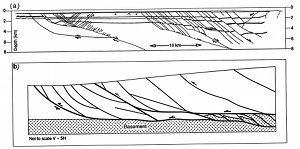| |||||||
|
|
|||||||
|
|
|||||||
| Splay Faults | |||||||
|
It has been long recognized by structural geologists that fault geometries are complex. This complexity is commonly introduced by bends, intersections, and steps. Related to intersecting or conjoining fault traces, several terms have been used in the literature for one or more faults diverging from, or converging onto, a more prominent fault. Adjectives such as main, master, primary, and first order versus minor, complementary, subsidiary, and second order are used to differentiate between the relative magnitudes and/or formation order of the faults involved. Anderson (1951) recognized a case from Britain with various intersection angles (Figure 1) and idealized a simple but common splay or branch geometry with an acute intersection angle to the main fault (Figure 2). The Alpine fault (Figure 3) in New Zealand was later used by Chinnery (1966) as a prototypical example of one type of splay geometry or secondary fault geometry (Type A in his terminalogy). All the examples above appear to be from strike-slip fault regimes with both the main fault and the splays interpreted to be strike-slip faults of the same sense as the main faults. However,strike-slip main faults with dip-slip splays are also common as illustrated in Figures 4 a and b for strike-slip and normal faults, and strike-slip and thrust faults combinations, respectively. With the advance of seismic imaging crustal scale examples of configurations involving dip-slip faults and their dip-slip splays became readily available, see, for example, Figure 5a, for normal faults and related splays near the top ends. Figure 5b illustrates a schematic diagram illustrating main low-angle thrust faults with thrust and reverse splay or branch geometries based primarily on field data.
Coexistence of strike-slip faults and dip-slip faults does not have to be within the context of splay or branch faults. The reader may also examine 'Assemblages of Different Types of Faults' for other types of associations. In the study of active faults, in which the primary objective is to understand rupture propagation with high velocities (dynamic cases) along preexisting faults, often the term fault branching is used (see, for example, Oglesby et al., 2003). A short summary of some results of these research efforts will be provided under 'Mechanisms and Mechanics of Splay Faults.' As will be pointed out there, in this Knowledgebase, our objective has been to understand how fractures in Earth's upper crust (5 to 10 km) initiate and evolve. Keeping this focus in mind, the readers are referred to the field description and analyses of the initiation and growth of faults by various mechanisms and the resulting fault splay geometries and their statistical properties. An important difference is that opening mode and closing mode splays commonly precede the shearing mode splays. A closely related process is splay jointing and splay pressure solution seams described and analyzed under 'Splay Joints,' 'Splay Pressure Solution Seams,' 'Mechanisms and Mechanics of Splay Joints,' and 'Mechanisms and Mechanics of Splay Pressure Solution Seams.' Please see the links below to investigate process-based concepts of splay faults. The notion is that once splay fractures form, they become prone to shearing and form sheared joints and sheared pressure solution seams and eventually lead to fault patterns similar to those summarized above. | |||||||
| Reference: |
|||||||
| Anderson, E.M., 1951 Boyer, S.E., Elliot, D., 1982 Chinnery, M.A., 1966 Kim, Y., Peacock, D.C.P., Sanderson, D.J., 2004 Oglesby, D.D., Day, S.M., Li, Y.G., Vidale, J.E., 2003 Xiao, H.B., Dahlen, F.A., Suppe, J., 1991 |
|||||||
|
Readme | About Us | Acknowledgement | How to Cite | Terms of Use | Ⓒ Rock Fracture Knowledgebase |
|||||||




